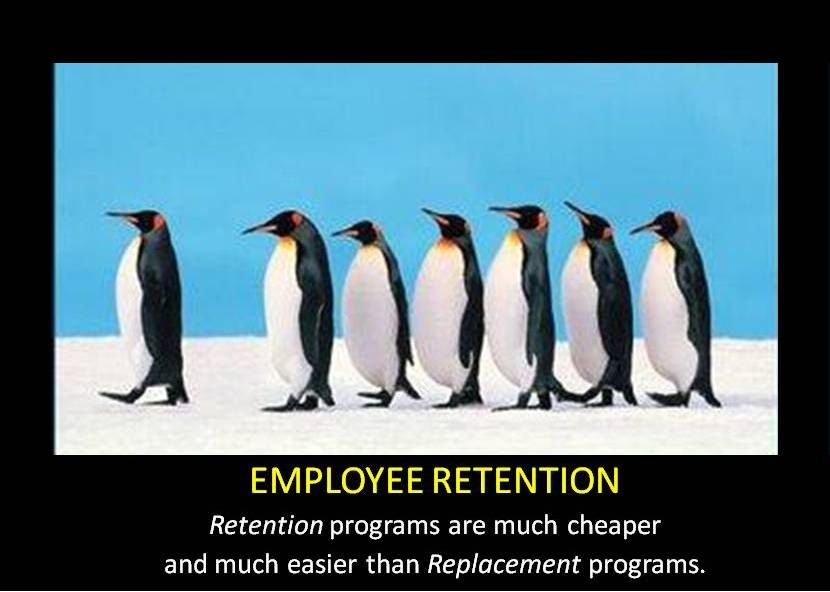That’s when your mind fills with questions. How did this happen? Is this my fault? Who else is leaving? Is there anything we could have done to prevent this?
It takes so much time and effort to recruit, interview, hire, and onboard a new employee, it is critically important to build an organization that is optimized for keeping people on the team for the long haul.
So, how can this be done? Let’s take a look at some proven ways to reduce employee turnover.
1. Involve Employees in Key Decisions
 Are you thinking about rebranding the company? Are you contemplating moving offices? Are you doing something as simple as changing the brand of coffee in the kitchen?
Are you thinking about rebranding the company? Are you contemplating moving offices? Are you doing something as simple as changing the brand of coffee in the kitchen?
Giving employees a chance to buy into changes and share their thoughts on pending decisions can create a strong and positive link between the team and the organization. Of course, not all employees can (or should!) partake in every major business decision. But there are many opportunities, large and small, to request employee feedback, suggestions, votes, and ideas.
This is especially true for daily interactions. The more frequently an employee comes into contact with something, the more important it is that they are able to weigh in on the outcome. How about helping select their very own coworkers? Enacting an employee referral system has many positive benefits for your company.
So, next time you are thinking about making a change, no matter how small, be sure to get your team's feedback!
2. Allow for Remote Work
More and more businesses are allowing employees to work from home or other locations. By providing your team with additional flexibility, they're able to more effectively manage their work-life balance and ensure that no matter what is going on with their lives — personal issues, relationship changes, family obligations, a disdain for rush hour traffic, etc. — they will be better able to deliver results and support the organization.
Granted, remote work doesn’t make sense for every business. Sometimes, employees have to be in same location, either in the the office or at client sites. But when possible, remote work should be seen as a positive.
There are dozens of apps and new(ish) technologies that make remote work easier than ever. And if you're looking to hire and retain your millennial employees, then it's likely you'll need to cater to their every whim and need. Just kidding! But you will need a remote work policy.
3. Reward Performance
If someone is doing exceptional work, let them know. Let the team know. Let their boss know. Sharing positive feedback on a regular basis is one of the most effective ways to keep employees happy, engaged, and on the team.
basis is one of the most effective ways to keep employees happy, engaged, and on the team.
Set aside a budget each quarter for ad hoc compensation for employees who are outperforming. It doesn't have to be much: coffee gift cards, lunches, perhaps a decent bottle of whiskey. But what matters most is that employees are recognized for their exceptional efforts.
Of course, if someone is really crushing it, then yes, they deserve a much larger reward. During your next one-on-one meeting, give them a spot bonus — a real one — and both you and the employee will win.
4. Provide a Career Path
Some employees leave because they don’t believe in the organization’s vision. Others depart for greater pay, greater flexibility, or greater opportunities to grow. This type of employee turnover — when talented, driven employees leave to take on roles with greater responsibility — can be reduced by providing a clear path to internal growth.
This can present itself in a number of ways: on-the-job training, third-party education, internal management courses, or even opportunities to attend industry conferences and seminars.
For enterprise businesses, another strategy is to be transparent with the organizational structure and share current and future open positions with your team. Through this, you can provide a literal path toward management roles for those individuals in your organization who have the will, effort, and skills to move upward.
5. Make Work Fun
This is easier said than done. Yes, happy hours, coffee meetings, and team lunches are all decent ways to get the team to interact with one another and have a good time.
But these are one-off events. It’s much more effective to make work itself fun. If you create a culture that cares about employee satisfaction and builds a truly positive workplace, your team is much more likely to stay on board through personal, professional, and financial challenges.
Granted, not everything can — or should — be fun. Some organizations are less capable of having a “fun” workplace than others. Another tactic is to simply ask your employees what activities they’d like to do. Perhaps it’s chocolate taste testing or something ridiculous like laser tag. Maybe your team wants to volunteer for a cause they believe in or spend the day playing mini golf. But until you ask them, you just won’t know.
6. Hold Weekly 1:1 Meetings
 Weekly one-on-one meetings are one of the most effective ways to get a better understanding of how your employees are doing — personally, professionally, and in relation to your department and company. By spending 30-60 minutes each week with your direct reports, you have the opportunity to learn not only how well they are progressing in terms of delivering on work, but also how they are feeling. One-on-one meetings also provide an opportunity to mentor your team and help set them up for success.
Weekly one-on-one meetings are one of the most effective ways to get a better understanding of how your employees are doing — personally, professionally, and in relation to your department and company. By spending 30-60 minutes each week with your direct reports, you have the opportunity to learn not only how well they are progressing in terms of delivering on work, but also how they are feeling. One-on-one meetings also provide an opportunity to mentor your team and help set them up for success.
Meeting Date
Review Last Week
New Topics to Discuss
Action Items
Notes
Here's a sample outline for a weekly 1:1. (It's intentionally simple! That's because you want to spend the meeting in conversation, rather than staring at a computer and taking a bunch of notes.)
7. Manage Employee Workloads
When employees are working 60+ hour weeks, spending weekends on their computer, or ordering dinner in the office because it’s another late evening on deadline, there is always one group who is blamed: management. If you want to keep your employees on your team, you have to understand who is available to take on additional work and how much time employees are spending on various projects.
No, resource planning is not particularly fun, but it’s the most simple and straightforward way to ensure workloads are properly distributed. And by gaining visibility into employee time, you’re able to predict hiring and contracting needs far ahead of time — making it much less likely your team will need to pull an all nighter or work through the weekend.
8. Conduct Exit Interviews
No matter how effective you are at reducing employee turnover, people are going to leave. Families will move cities. Recruiters will knock on the door of your top talent. Sometimes, it’s just time to move on.
But a departing employee is also an opportunity: You can learn what your now-former colleague truly thinks about the company, the management team, the product, the culture, etc.
This feedback is invaluable and should be shared (when possible) with other managers and team members who are working to improve employee engagement — or really any aspect of the business that affects the larger team.
Hey there !
Author Details
Related Blogs
Popular Tags
Subscribe Now









